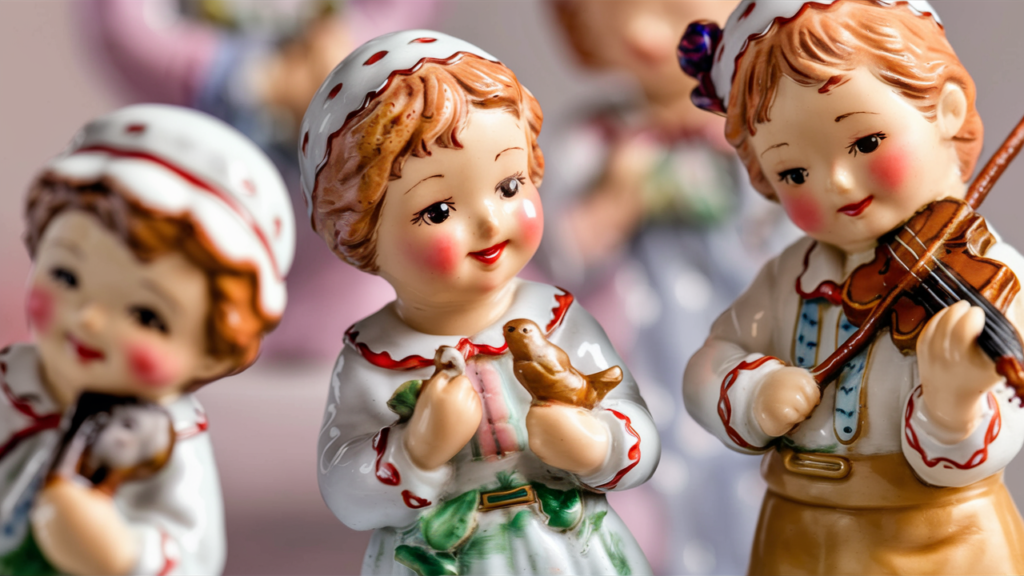From Convent Sketches to Collectible Icons: The Enduring Legacy of German Hummel Figurines
GERMAN HERITAGE USA | AFFILIATE DISCLAIMER: This post may or may not contain affiliate links which means we may receive a commission for purchases made through links. We will only recommend products that we have personally used or that we truly trust. Learn more on our Private Policy and Disclaimer Page located under our Terms Of Service tab above.
Nestled amidst the rolling hills of Bavaria, Germany, lies a convent that holds the key to a unique cultural phenomenon: Collectible German Hummel figurines. These charming porcelain figures, with their rosy-cheeked children and quaint scenes, have captured hearts worldwide for over eight decades.

But their journey, from the pen of a talented nun to beloved collectibles, is steeped in German history and artistry.
The Artistic Roots: Sister Maria Innocentia Hummel
The story begins with Berta Hummel, born in 1909 in southern Germany. As a young girl, her artistic talent shone through, leading her to pursue art school. In 1931, she joined the Franciscan convent in Siessen, Bavaria, taking the name Sister Maria Innocentia. Despite the strict religious life, her artistic spirit remained alive, and she began creating whimsical sketches of children playing, singing, and enjoying simple joys. These sketches, imbued with innocence and warmth, quickly gained popularity within the convent and beyond.
From Paper to Porcelain: The Collaboration with Goebel
Sister Maria Innocentia’s drawings caught the eye of Franz Goebel, head of the renowned German porcelain company W. Goebel Porzellanfabrik. Recognizing the potential of her work, he approached the convent in 1934 with a bold proposal: to translate her two-dimensional artwork into three-dimensional ceramic figurines. The collaboration was born, and the first Hummel figurines, featuring ten designs, were unveiled at the Leipzig Trade Fair in 1935.
Instant Success and a Complex History
The figurines were an instant hit. Their endearing charm resonated with audiences during a time of economic hardship and political turmoil in Europe. The figurines offered a glimpse of carefree childhood, innocence, and simple pleasures, providing a welcome escape from reality. However, the Hummel figurines’ history is not without controversy.
Post-War Evolution and Enduring Legacy
Hummel figurines continued to be produced after the 1940’s, gaining even more popularity in the United States and other Western countries. They became symbols of nostalgia, representing childhood memories and cherished family traditions.

The production process remained meticulous, with skilled artisans meticulously hand-crafting each figurine, ensuring the highest quality and attention to detail.
Today and Beyond: A Collectible Treasure
Today, Hummel figurines remain a beloved collectible item. Their timeless appeal continues to draw collectors and enthusiasts worldwide. While production has faced challenges in recent years, the brand’s legacy endures. Museums exhibit vintage Hummel pieces, and dedicated collectors hunt for rare and limited editions. The figurines continue to spark joy and evoke a sense of nostalgia, reminding us of simpler times and the enduring charm of childhood.
Beyond the Porcelain: A Cultural Touchstone
Hummel figurines are more than just collectibles; they are a cultural touchstone, offering a glimpse into German history, art, and values. They represent the power of art to bring joy and comfort, even during challenging times. The story of Sister Maria Innocentia Hummel, a talented artist who found her voice within the confines of a convent, and her collaboration with Goebel, a visionary entrepreneur, continues to inspire and captivate. In the end, these porcelain figures serve as a testament to the enduring power of creativity and the universal language of innocence and joy.
Each Hummel figurine embodies a unique story, waiting to be discovered. Consider the iconic “Boy on a Sled” (Hummel #351), a playful depiction of a boy careening down a snowy hill, his cheeks flushed with excitement. This figurine, introduced in 1935, quickly became a symbol of winter joy and carefree childhood. Another beloved piece is “Apple Strudel Time” (Hummel #84), showcasing a grandmother and child preparing the delectable pastry. This heartwarming scene evokes memories of family traditions and the comforting aroma of baked goods.
A Meticulous Craft: The Heartbeat of Hummel
Crafting these intricate figurines is an art form in itself. Each piece undergoes a meticulous 140-step process, adhering to the highest standards of quality and craftsmanship. Skilled artisans utilize traditional techniques like mold-making, casting, glazing, and hand-painting to bring Sister Maria Innocentia Hummel’s sketches to life. The delicate details, from the rosy cheeks and expressive eyes to the intricate clothing folds and realistic textures, showcase the dedication and artistry poured into each creation.
Evolving with Time: The Hummel Brand Journey
The Hummel brand has not remained static over the years. While classic designs continue to hold a special place in collectors’ hearts, the company has also introduced new figurines capturing contemporary themes and aesthetics.

Collaborations with modern artists and designers have infused the brand with fresh energy, ensuring its relevance for new generations. Additionally, the company has expanded its offerings beyond figurines, creating home decor items, jewelry, and other collectibles, catering to a wider audience.
Hummel in Pop Culture: A Touch of Porcelain Magic
Beyond their collectible value, Hummel figurines have made their mark on popular culture. They have appeared in movies, television shows, and even music videos, often serving as nostalgic props or symbols of innocence and tradition. Their enduring popularity reflects their ability to resonate with audiences across generations and cultures.
Collecting the Past, Embracing the Future: The Allure of Hummel
Hummel figurines offer a unique window into German history, art, and values. They represent a testament to the enduring power of creativity, human connection, and the simple joys of childhood. Whether cherished as collectibles, admired for their craftsmanship, or used as conversation starters about a complex past, these porcelain figures continue to spark joy and inspire curiosity.
As the brand evolves and adapts to changing times, the legacy of Sister Maria Innocentia Hummel and her charming creations lives on, offering a lasting reminder of the beauty and warmth found in everyday moments.
